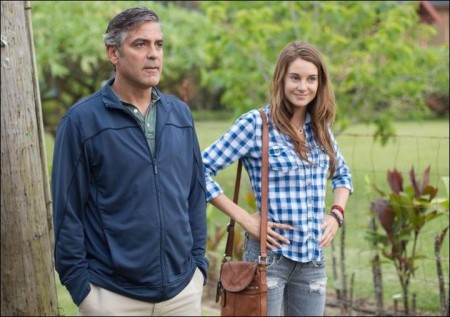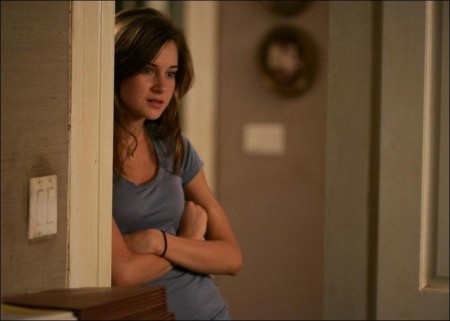“My grandfather, he really loved this place. So did your mother. So does your mother.” — Matt King
A strong sense of place has always been a hallmark of Alexander Payne‘s work but with THE DESCENDANTS it would become even more central. From the beginning, he and his crew of frequent collaborators were acutely aware that they were going where few filmmakers have gone before by following an intimate family drama into the lush fabric of Hawaii. All of the conflicting juxtapositions of contemporary Hawaiian culture – modern and ancient, urban and wild, growth and preservation – became wrapped into the film‘s design, from the photography to the sets.
The newest of the U.S. states, Hawaiian history goes back 1500 years, when Polynesian explorers first sailed canoes by the light of the stars to the fertile string of volcanic islands. Later, settlers arrived from across Polynesia – Tahiti, Samoa and Tonga – forging a distinctive matriarchal culture with its own language, customs, art forms and legends. In 1810, King Kamehameha, Chief of the Big Island, united all the islands into one Hawaiian Kingdom.
Soon after, Christian missionaries began to arrive, followed by colonialists from mainland United States. In 1893, a group of American businessmen overthrew the Hawaiian monarchy, paving the way for annexation. Meanwhile, the culture continued to evolve and adapt, merging elements of American values with native Hawaiian ways. When Hawaii became a U.S. state in 1959, it was dubbed the Aloha state, reflecting the impossible-to-translate Hawaiian word that conveys an open-hearted spirit rooted in a love of the land.
To capture the islands as they are today – as rife with developers and suburbia as they are with laid-back surfers and Polynesian traditions — with a fresh eye, Payne reunited with director of photography Phedon Papamichael, who previously worked with him on SIDEWAYS. As soon as he read the script, Papamichael knew it was going to be something different. It was a very dialogue-driven story, which usually means the film will be less visual, he begins. But in the case, the opposite was true. Because of the way the Hawaiian setting is juxtaposed with the King family’s struggles, the visuals take on a major role. It was going to be very important to capture the beauty and nature of the surrounding environment so you can understand the conflict Matt feels over selling his family‘s land.
Papamichael divided the film between two Hawaiis: the more hectic, citified Hawaii of Honolulu and the stunning, natural Mecca of Hanalei Bay on the island of Kauai, draped with verdant, tropical rainforests and surrounded by sapphire seas. ¯We really wanted to give a feeling for the community in Honolulu but also the beauty of the coast so you understand what could be lost and the connection to history that is there. That‘s why we decided to shoot wide-screen, which Alexander has only done once before, on ELECTION, he explains. We decided that it would be a lot of fun to have that epic frame with these small, human figures confronted with the majesty of the landscape.
At the same time, both men wanted the film to stay true to Payne‘s distinctively unadorned style, which is almost an anti-style. I like to bring an almost documentary style to fiction filmmaking, says Payne. It gives the story a sense of reportage.
Papamichael concurs. “With Alexander, one of the biggest assignments is always to make sure the photography doesn‘t get in the way of the story. He really loves realism, to the point that if we go to a location and there are tree trimmers working nearby”, he says “great” and he embraces that as part of what‘s going on in the scene, he explains. Or, for example, when we shot in the bar where George Clooney meets Beau Bridges, it was very important to Alexander to have the real locals who frequent the place be in there to get that feel of reality. The same goes for lighting. It‘s always very natural, to the point that the audience should never realize that they‘re watching a crafted film.
He continues, “We really want the audience to be taken in by the characters without distraction. The emotions are so intense and the writing so strong, we don‘t need to add visual drama.”
Hawaii, however, often brought its own drama. The light there is challenging because it is constantly changing, notes Papamichael. It can go from overcast to sunny in the time frame of one shot. Fortunately, both Alexander and George, being a filmmaker himself, are very good at reacting in the moment so you can switch scenes around. It gave us a lot of flexibility.
Some of the filming for THE DESCENDANTS also took place off terra firma – in swimming pools and the ocean. Legendary underwater photographer Don King came in to help with the scene where Shailene Woodley releases a primal scream while at the depths of the family swimming pool.
Recalls Woodley, “He waited for me underwater with this crazy-looking camera. I would submerge myself and swim towards him and he would swim backwards super quickly, timing it perfectly with me. It was a fantastic scene to shoot.”
One of Papamichael‘s favorite experiences on THE DESCENDANTS was filming the climax of Matt‘s road trip as the Kings arrive at their ancestral land on Kauai and young Scottie makes Matt rethink the idea of selling it to strangers. We designed the shot so the family drives up the mountain but you‘re not really aware of what‘s coming. It almost feels like a normal tracking shot but then, as they come to the edge of the land, we boom up and reveal this spectacular view, and suddenly, the characters are overwhelmed by the beauty. That was one of my favorites, sums up Papamichael.
Payne also reunited with production designer Jane Ann Stewart, who has worked on all of his films since the very beginning of his career. Stewart says that Payne‘s aesthetic instincts jibe with hers. His sense of humor is very much like mine – absurd, a little macabre and where nothing in the human condition is above comedy, she says.
She knew her work was cut out for her when Payne approached her for this film. We both had to learn a lot about Hawaiian culture, and really immerse ourselves in it, so we could get to the history, the sense of place and the texture behind the story, she explains.
In creating Matt King‘s house, Stewart consulted both with the novel and its author, Kaui Hart Hemmings. “Kaui‘s advice was invaluable,” says Stewart. “For example, she introduced me to the punee [the casual Hawaiian daybeds often used as sprawling sofas] and helped us to reflect the family‘s history in the details.”
When Stewart found a local house that had the right feel, it was missing one key element – the sprawling banyan tree that graced the front yard in the book. So Stewart had one transplanted. It kind of reflects the idea of family because of the way each branch reaches in and plants itself, she observes.
As with the cinematography, Stewart‘s challenge was to keep things in Payne‘s favored realm of stark reality, but with a tropical twist. Alexander always wants the veneer to be authentic, even a little bit banal. But this film was a chance for me to stretch things a bit with the colors and exotic essence of the place. I just had to have a very good reason for putting anything, a piece of furniture or painting, in a room. It had to support the characters and stay true to the place.
That authenticity to Hawaii deeply moved Hemmings when she visited the set – and she could see her story coming to life, reflecting the funny and fraught ways that families, on or off the islands, really interact and bond. “It was amazing for me to be back in Hanalei Bay, where my own descendants first landed,” she says, “and it meant a lot to see the cast and crew getting to know this special, special place. It was a chance for me to reconnect with my own family and it brought the community together. Writing a book is such a solitary thing, but with a movie, the beauty is in sharing the experience.”
Read the Full Production Notes for The Descendants
Views: 209





